Tegawendé F. Bissyandé
University of Luxembourg
LuxInstruct: A Cross-Lingual Instruction Tuning Dataset For Luxembourgish
Oct 08, 2025Abstract:Instruction tuning has become a key technique for enhancing the performance of large language models, enabling them to better follow human prompts. However, low-resource languages such as Luxembourgish face severe limitations due to the lack of high-quality instruction datasets. Traditional reliance on machine translation often introduces semantic misalignment and cultural inaccuracies. In this work, we address these challenges by creating a cross-lingual instruction tuning dataset for Luxembourgish, without resorting to machine-generated translations into it. Instead, by leveraging aligned data from English, French, and German, we build a high-quality dataset that preserves linguistic and cultural nuances. We provide evidence that cross-lingual instruction tuning not only improves representational alignment across languages but also the model's generative capabilities in Luxembourgish. This highlights how cross-lingual data curation can avoid the common pitfalls of machine-translated data and directly benefit low-resource language development.
Memorization or Interpolation ? Detecting LLM Memorization through Input Perturbation Analysis
May 05, 2025Abstract:While Large Language Models (LLMs) achieve remarkable performance through training on massive datasets, they can exhibit concerning behaviors such as verbatim reproduction of training data rather than true generalization. This memorization phenomenon raises significant concerns about data privacy, intellectual property rights, and the reliability of model evaluations. This paper introduces PEARL, a novel approach for detecting memorization in LLMs. PEARL assesses how sensitive an LLM's performance is to input perturbations, enabling memorization detection without requiring access to the model's internals. We investigate how input perturbations affect the consistency of outputs, enabling us to distinguish between true generalization and memorization. Our findings, following extensive experiments on the Pythia open model, provide a robust framework for identifying when the model simply regurgitates learned information. Applied on the GPT 4o models, the PEARL framework not only identified cases of memorization of classic texts from the Bible or common code from HumanEval but also demonstrated that it can provide supporting evidence that some data, such as from the New York Times news articles, were likely part of the training data of a given model.
The Code Barrier: What LLMs Actually Understand?
Apr 14, 2025Abstract:Understanding code represents a core ability needed for automating software development tasks. While foundation models like LLMs show impressive results across many software engineering challenges, the extent of their true semantic understanding beyond simple token recognition remains unclear. This research uses code obfuscation as a structured testing framework to evaluate LLMs' semantic understanding capabilities. We methodically apply controlled obfuscation changes to source code and measure comprehension through two complementary tasks: generating accurate descriptions of obfuscated code and performing deobfuscation, a skill with important implications for reverse engineering applications. Our testing approach includes 13 cutting-edge models, covering both code-specialized (e.g., StarCoder2) and general-purpose (e.g., GPT-4o) architectures, evaluated on a benchmark created from CodeNet and consisting of filtered 250 Java programming problems and their solutions. Findings show a statistically significant performance decline as obfuscation complexity increases, with unexpected resilience shown by general-purpose models compared to their code-focused counterparts. While some models successfully identify obfuscation techniques, their ability to reconstruct the underlying program logic remains constrained, suggesting limitations in their semantic representation mechanisms. This research introduces a new evaluation approach for assessing code comprehension in language models and establishes empirical baselines for advancing research in security-critical code analysis applications such as reverse engineering and adversarial code analysis.
Is LLM the Silver Bullet to Low-Resource Languages Machine Translation?
Mar 31, 2025Abstract:Low-Resource Languages (LRLs) present significant challenges in natural language processing due to their limited linguistic resources and underrepresentation in standard datasets. While recent advancements in Large Language Models (LLMs) and Neural Machine Translation (NMT) have substantially improved translation capabilities for high-resource languages, performance disparities persist for LRLs, particularly impacting privacy-sensitive and resource-constrained scenarios. This paper systematically evaluates the limitations of current LLMs across 200 languages using benchmarks such as FLORES-200. We also explore alternative data sources, including news articles and bilingual dictionaries, and demonstrate how knowledge distillation from large pre-trained models can significantly improve smaller LRL translations. Additionally, we investigate various fine-tuning strategies, revealing that incremental enhancements markedly reduce performance gaps on smaller LLMs.
Enhancing Small Language Models for Cross-Lingual Generalized Zero-Shot Classification with Soft Prompt Tuning
Mar 25, 2025Abstract:In NLP, Zero-Shot Classification (ZSC) has become essential for enabling models to classify text into categories unseen during training, particularly in low-resource languages and domains where labeled data is scarce. While pretrained language models (PLMs) have shown promise in ZSC, they often rely on large training datasets or external knowledge, limiting their applicability in multilingual and low-resource scenarios. Recent approaches leveraging natural language prompts reduce the dependence on large training datasets but struggle to effectively incorporate available labeled data from related classification tasks, especially when these datasets originate from different languages or distributions. Moreover, existing prompt-based methods typically rely on manually crafted prompts in a specific language, limiting their adaptability and effectiveness in cross-lingual settings. To address these challenges, we introduce RoSPrompt, a lightweight and data-efficient approach for training soft prompts that enhance cross-lingual ZSC while ensuring robust generalization across data distribution shifts. RoSPrompt is designed for small multilingual PLMs, enabling them to leverage high-resource languages to improve performance in low-resource settings without requiring extensive fine-tuning or high computational costs. We evaluate our approach on multiple multilingual PLMs across datasets covering 106 languages, demonstrating strong cross-lingual transfer performance and robust generalization capabilities over unseen classes.
CallNavi: A Study and Challenge on Function Calling Routing and Invocation in Large Language Models
Jan 09, 2025
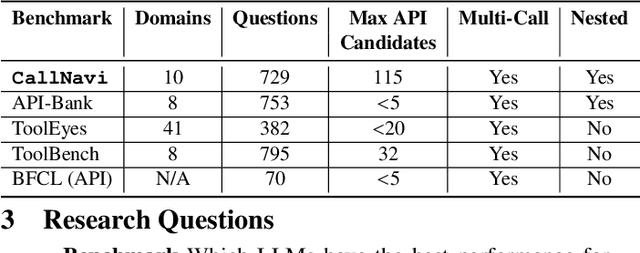


Abstract:Interacting with a software system via a chatbot can be challenging, especially when the chatbot needs to generate API calls, in the right order and with the right parameters, to communicate with the system. API calling in chatbot systems poses significant challenges, particularly in complex, multi-step tasks requiring accurate API selection and execution. We contribute to this domain in three ways: first, by introducing a novel dataset designed to assess models on API function selection, parameter generation, and nested API calls; second, by benchmarking state-of-the-art language models across varying levels of complexity to evaluate their performance in API function generation and parameter accuracy; and third, by proposing an enhanced API routing method that combines general-purpose large language models for API selection with fine-tuned models for parameter generation and some prompt engineering approach. These approaches lead to substantial improvements in handling complex API tasks, offering practical advancements for real-world API-driven chatbot systems.
LuxEmbedder: A Cross-Lingual Approach to Enhanced Luxembourgish Sentence Embeddings
Dec 05, 2024



Abstract:Sentence embedding models play a key role in various Natural Language Processing tasks, such as in Topic Modeling, Document Clustering and Recommendation Systems. However, these models rely heavily on parallel data, which can be scarce for many low-resource languages, including Luxembourgish. This scarcity results in suboptimal performance of monolingual and cross-lingual sentence embedding models for these languages. To address this issue, we compile a relatively small but high-quality human-generated cross-lingual parallel dataset to train LuxEmbedder, an enhanced sentence embedding model for Luxembourgish with strong cross-lingual capabilities. Additionally, we present evidence suggesting that including low-resource languages in parallel training datasets can be more advantageous for other low-resource languages than relying solely on high-resource language pairs. Furthermore, recognizing the lack of sentence embedding benchmarks for low-resource languages, we create a paraphrase detection benchmark specifically for Luxembourgish, aiming to partially fill this gap and promote further research.
DetectBERT: Towards Full App-Level Representation Learning to Detect Android Malware
Aug 29, 2024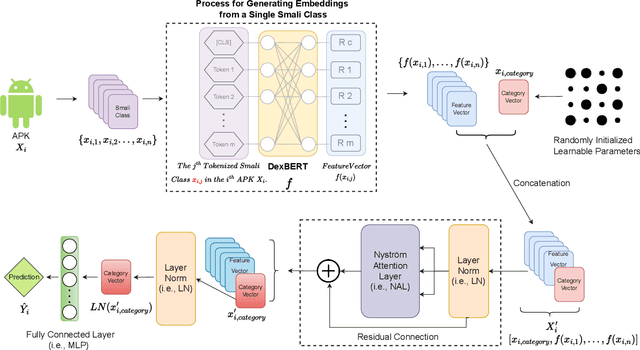



Abstract:Recent advancements in ML and DL have significantly improved Android malware detection, yet many methodologies still rely on basic static analysis, bytecode, or function call graphs that often fail to capture complex malicious behaviors. DexBERT, a pre-trained BERT-like model tailored for Android representation learning, enriches class-level representations by analyzing Smali code extracted from APKs. However, its functionality is constrained by its inability to process multiple Smali classes simultaneously. This paper introduces DetectBERT, which integrates correlated Multiple Instance Learning (c-MIL) with DexBERT to handle the high dimensionality and variability of Android malware, enabling effective app-level detection. By treating class-level features as instances within MIL bags, DetectBERT aggregates these into a comprehensive app-level representation. Our evaluation demonstrates that DetectBERT not only surpasses existing state-of-the-art detection methods but also adapts to evolving malware threats. Moreover, the versatility of the DetectBERT framework holds promising potential for broader applications in app-level analysis and other software engineering tasks, offering new avenues for research and development.
Revisiting Code Similarity Evaluation with Abstract Syntax Tree Edit Distance
Apr 12, 2024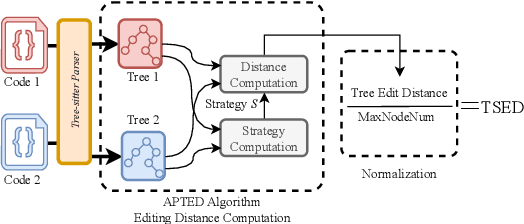

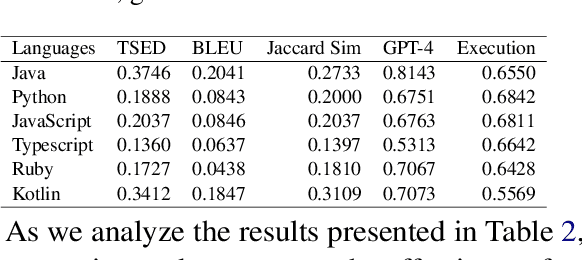
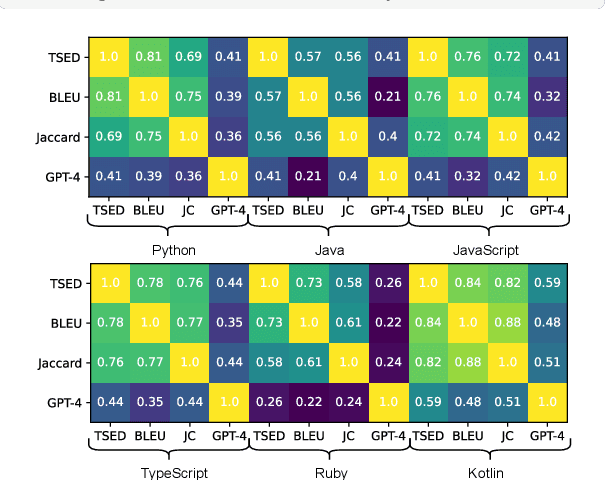
Abstract:This paper revisits recent code similarity evaluation metrics, particularly focusing on the application of Abstract Syntax Tree (AST) editing distance in diverse programming languages. In particular, we explore the usefulness of these metrics and compare them to traditional sequence similarity metrics. Our experiments showcase the effectiveness of AST editing distance in capturing intricate code structures, revealing a high correlation with established metrics. Furthermore, we explore the strengths and weaknesses of AST editing distance and prompt-based GPT similarity scores in comparison to BLEU score, execution match, and Jaccard Similarity. We propose, optimize, and publish an adaptable metric that demonstrates effectiveness across all tested languages, representing an enhanced version of Tree Similarity of Edit Distance (TSED).
Soft Prompt Tuning for Cross-Lingual Transfer: When Less is More
Feb 06, 2024



Abstract:Soft Prompt Tuning (SPT) is a parameter-efficient method for adapting pre-trained language models (PLMs) to specific tasks by inserting learnable embeddings, or soft prompts, at the input layer of the PLM, without modifying its parameters. This paper investigates the potential of SPT for cross-lingual transfer. Unlike previous studies on SPT for cross-lingual transfer that often fine-tune both the soft prompt and the model parameters, we adhere to the original intent of SPT by keeping the model parameters frozen and only training the soft prompt. This does not only reduce the computational cost and storage overhead of full-model fine-tuning, but we also demonstrate that this very parameter efficiency intrinsic to SPT can enhance cross-lingual transfer performance to linguistically distant languages. Moreover, we explore how different factors related to the prompt, such as the length or its reparameterization, affect cross-lingual transfer performance.
 Add to Chrome
Add to Chrome Add to Firefox
Add to Firefox Add to Edge
Add to Edge